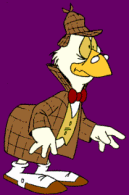ABSTRACT
It has been noted that certain cartoon series such as Tom and Jerry (Quimby Era) [1], Mickey Mouse [2] ,Bugs Bunny [3] and Count Duckula [4] are more likely to produce chuckles from the average non-philistine spectator than Tom and Jerry (Jones Era) [5] - and anything else on either Nickelodeon or Cartoon Network today. In this work, a frequency domain methodology to arrive at a correlation between the funniness (the probability to produce a chuckle) and the spectral densities at higher frequencies has been described. Quantitative results have been withheld, since this information is very sensitive and might lead to the development of funny cartoons by countries within the axis of evil. It is undesirable to have happy enimies, for happiness results in a lifted morale.
It has been noted that certain cartoon series such as Tom and Jerry (Quimby Era) [1], Mickey Mouse [2] ,Bugs Bunny [3] and Count Duckula [4] are more likely to produce chuckles from the average non-philistine spectator than Tom and Jerry (Jones Era) [5] - and anything else on either Nickelodeon or Cartoon Network today. In this work, a frequency domain methodology to arrive at a correlation between the funniness (the probability to produce a chuckle) and the spectral densities at higher frequencies has been described. Quantitative results have been withheld, since this information is very sensitive and might lead to the development of funny cartoons by countries within the axis of evil. It is undesirable to have happy enimies, for happiness results in a lifted morale.
INTRODUCTION
The spectrum has been around ever since that day when Fourier dreamed up his series and transform. The fourier transform is widely used in a discretized from in software such as Winamp to show the frequency content of an unstationary music (mp3) signal and also in critical space applications. (I'm sure it is used somewhere in space, right). Two dimensional fourier transforms are used by Net Nanny (possibly) to block po rnographic images - and they have also been used in the JPEG format of pictures, making possible the entire internet.
The spectrum has been exploited in movies such as G hostbusters and Ghost and numerous Indian movies too, which employ scenes of the supernatural. Turbulent flows show a cascading behavior in the spectral domain, something that seemed to be lost behind the noise in the time domain.
Cartoons have been around for a long time, and are universally accepted as examples of man on the pinnacle of his naughty creativity; right from the first Tom and Jerrys to the lump of mucus that graces the screen in those Mucinex commericals. Characters such as Dr. Von Goosewing and Daffy Duck send the average human into peals of laughter. Yet modern cartoons (the entire gamut of shows that cartoon network has to offer now, for one!) are unlikely to make anyone with an IQ exceeding that of a crushed pea laugh. South Park is more likely to make people Vomit than laugh, though the Simpsons has its funny times every now and then.
Common sense would tell us that it is just creativity that is lacking. But we beg to differ. Be believe that there are sinister forces afoot here. We postulate that the curvature of the edges of the cartoon is indicative of the funniness - the straighest edge resulting in a drag. We use a frequency domain method to estimate the harmonic content within an edge: the lower the harmonic content, the funnier the cartoon. We expect a straight line between funniness and power at higher frequencies.
RESULTS
Censored. Only harmless pictures allowed.

Cat, Tom: Chuck Jones Era. Observe sharper nose. Distinctly unfunny.
Federal Law forbids further discussion.
Conclusion
Cartoons with sharper edges tend to be way more boring than rounder cartoons.
Refrences
1 .... 10 : Google.com: googling referenced term suffices.
Warning
It is strongly recommended that this study be taken with a pinch of salt and be quoted exclusively to quoters' risk. Author shall not be liable for any hurt egos.

1 comment:
I so agree with your view on cartoons. I'm more of a Count Duckula fan, myself. They don't make cartoons like they used to... *sigh*
Post a Comment